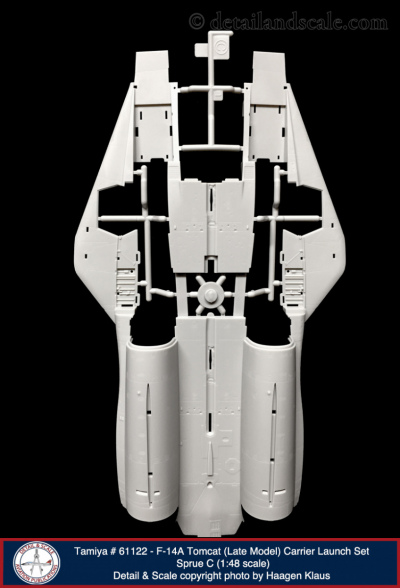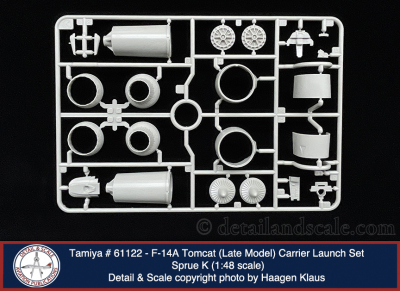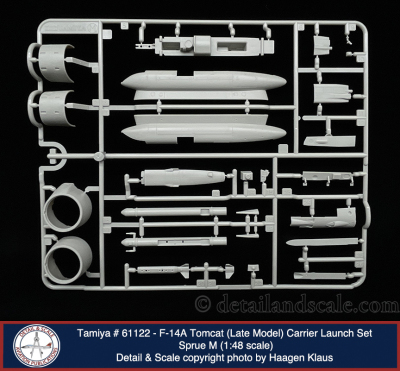Tamiya # 61122
F-14A Tomcat (Late Model) Carrier Launch Set
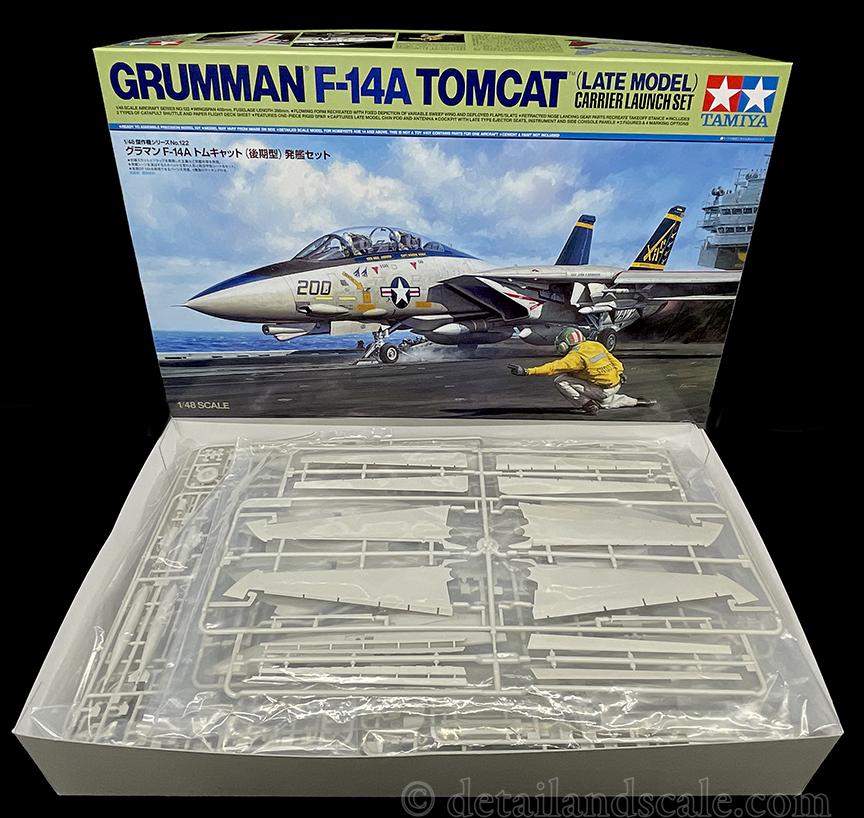
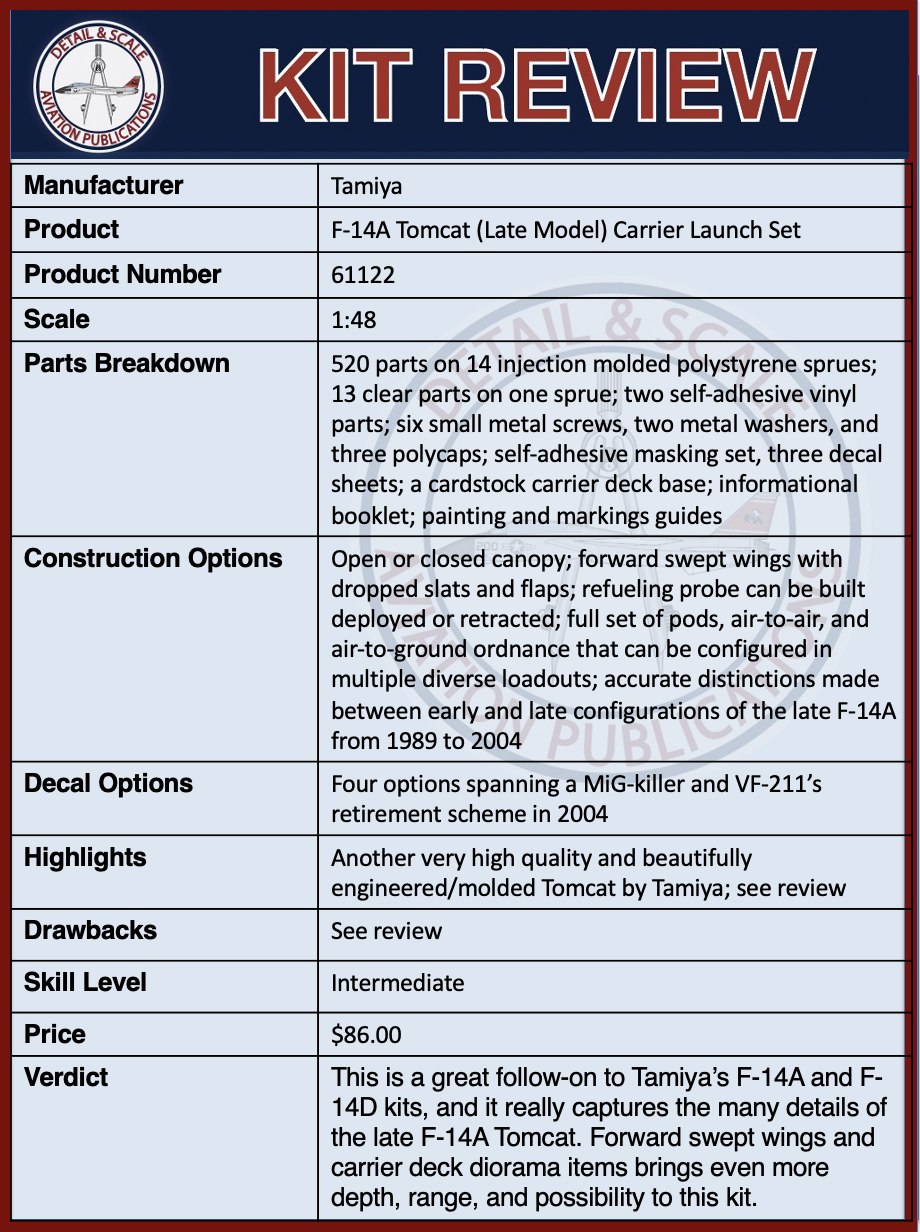
To date, there have been some 400 different issues of F-14 Tomcat kits in all the major scales produced by nearly every scale model manufacturer. In my latest Detail & Scale publication on the F-14, the Scale Modeling Section looks at the full range of contemporary Tomcat kits. The Tamiya 1:48 scale F-14s rises above them all, owing to its excellent attention to detail, thoughtful engineering, and virtually perfect fit. Many scale modelers reasonably state that Tamiya Tomcats are among the best scale model kits ever made. In this review, we take a look at the third 1:48 scale Tomcat released by Tamiya. This kit has been out for more than a year and it is described in the aforementioned publication, but we have only had a chance write this in-depth review just recently. This new offering has a substantial range of new parts to build a late-life F-14A – and a set of new, forward-swept wings and other parts to go along with a carrier deck base representing a carrier launch scene.

The Tomcat was born from the ashes of the F-111B program in the late 1960s. The F-14 was originally conceived as a long-range fleet defense interceptor and air superiority fighter, fielding the AN/AWG-9 radar/Phoenix missile combination to protect U.S. Navy battle groups from long range Soviet bomber and cruise missile threats. It was the first of the fourth-generation American fighters to apply the lessons learned in the Vietnam War, such as the need for an internal cannon, 360 degrees of visibility, and excellent maneuverability. The Tomcat’s variable geometry wings literally changed the airplane’s shape in flight to optimize its aerodynamics. Particularly with its wings full forward and flaps down, the F-14 was famously capable of “bat turns” that could allow Grumman’s “Big Fighter” to gain the advantage over the most nimble of opponents. With the development of the TARPS pod system, the Tomcat added aerial reconnaissance to its mission. By the mid 1990s, it evolved into an indispensable heavy strike-fighter, a forward air controller, and an armed reconnaissance platform thanks to the addition of a modified LANTIRN targeting pod and precision laser- and GPS-guided munitions.
Grumman manufactured 712 Tomcats between 1970 and 1992 across three variants. Of that total, 557 were F-14As fitted with the sometimes-troublesome TF30 powerplants. Over its lifetime, the F-14A was continiously upgraded. The last F-14A, which was retired in 2004, was a very different airplane than the first production F-14A. Changes included multiple incremental upgrades, from updates to the AN/AWG-9 radar and flight control computers, to a new rear cockpit display, ECM systems, external stores, significantly improved TF30 engines, and other features. These upgrades not only kept the Tomcat relevant following the end of the Cold War but placed them at the vanguard of defending against the new threats of the early 21st century. F-14s provided key contributions to both Operations ENDURING FREEDOM and IRAQI FREEDOM. Of the few remaining F-14As then in service, jets from VF-41 “Black Aces” led some of the first strikes over Afghanistan in October 2001. F-14As from VF-154 “Black Knights” developed unique partnerships with U. S. special operators where they supported highly covert ground operations in Iraq in 2003. The last F-14A was flown by VF-211 “Checkmates” and retired in 2004, two years before the final Tomcat flight by an F-14D.

Tamiya’s 1:48 scale F-14A Tomcat (Late Model) Carrier Launch Set kit contains 520 parts on 14 injection molded polystyrene sprues, 13 clear parts on one sprue, two self-adhesive vinyl parts, six small metal screws, two metal washers, three small polycaps, a self-adhesive masking set, four decal sheets, a cardstock carrier deck base, and a concise informational booklet on the F-14 in various languages. The well-illustrated instruction booklet guides the build over 49 steps. A double-sided full-color painting and decal placement guide is also included covering the following four Tomcats:
- F-14A BuNo. 162701, VF-32 “Swordsmen” CAG aircraft, NAS Oceana, May 1990
- F-14A BuNo. 159610, VF -32 “Swordsmen” USS JOHN F. KENNEDY, January 1989
- F-14A BuNo. 161603, VF -211 “Checkmates” CO’s aircraft, NAS Oceana, March 2004
- F-14A BuNo. 161276, VF -154 “Black Knights” CO’s aircraft, NAF Atsugi, Japan, May 2003.
Strengths: By now, many scale modelers know of the reputation that Tamiya’s 1:48 scale F-14s have earned quite deservedly (and you can find our in-depth reviews of their previous F-14A and F-14D kits on our website HERE, while more concise versions can be found in our recent publication on the Tomcat. While these kits are not flawless (see below), Tamiya’s 1:48 Tomcats are still the most accurate F-14s in any scale. Fit is impeccable and despite the high parts count, the model builds quickly and almost effortlessly. Lots of scale modelers gush about how enjoyable it is to build a Tamiya F-14, and your reviewer concurs with that assessment.
What is new in this version of the kit? The most obvious change is the new set of wings. One feature I lightly critiqued in previous reviews was the lack of building options involving the wings. Unlike the much older Hasegawa and Hobby Boss kits, only “clean” wings are supplied in Tamiya’s earlier F-14A and F-14D kits – but you could position the wings in either a fixed full-forward or fixed swept back position. Here, there are one set of wings with only one position option. The wings in this kit are set in the twenty-degree, full-forward position and feature extended leading edge slats and dropped flaps. The parts breakdown for the slats is interesting and smart. The slat rails are molded integrally to the bottom of the slat on one side, and to the bottom forward wing section on the other side. It is a clever engineering solution that ensures perfect alignment and slat angle along with ease of masking and painting the slat rails (quite often, not red, but a dark gunmetal color). The only downside is a fine seam at the front of each leading edge slat where the upper and lower halves join. Tamiya did get the right number of flap hinges (there are five per wing, not four as in the Hasegawa kits). A very secure fit is ensured by the way the flap hinge parts attach to the wing and join with the flap.
Many of the other details (and some are pretty subtle) that defined a late model F-14 are well captured by Tamiya in this kit. Starting with the cockpit, non-ribbed GRU-7A ejection seat cushions are nicely depicted. The RIO’s cockpit has parts for the large PTID display and the LANTIRN hand controller. The pilot’s instrument panel is updated to feature the small AN/ALQ-126 radar warning receiver display. There are two additional pilot figures that are wearing accurate gear for the late 1990s/early 2000s.
On the exterior, the AN/AAX-1 Television Camera System chin pod is featured along with the earlier (and not appropriate for the late F-14A) bullet-fairing chin pod common in the mid- to late 1980s. The four sets of fairings for the AN/ALQ-126 antennas on the underside of the wing glove are provided. Parts are also present to depict your model with the AN/ALQ-67 ECM system with the left nose gear door antenna fairing (but check you references, as only select late F-14As were retrofitted with the system). NACA-style gun gas purge air inlets are included, and the two-vent grill system (common the F-14 into the early 1990s) is also provided. The standard production F-14A wheel hubs are well done. The kit also contains an alternative nose landing gear in the “kneeling’’ position with a separate part for the catapult holdback bar. That, combined with a new figure depicting a catapult officer giving the launch signal and the cardstock carrier deck base, allows the scale modeler to depict their F-14A in a diorama representing the last moment before departing the ship.
Tomcat weapons and weapon systems evolved significantly over time, and this kit features the appropriate stores. It includes the standard set of AIM-7, AIM-9, and AIM-54 missiles seen in the other versions of the kit. Added in this boxing are various weapons present in the F-14D boxing, such as four Mk. 82 low-drag general-purpose bombs, two 500-pound laser-guided GBU-12s, two 1,000-pound laser-guided GBU-16s, a TARPS reconnaissance pod, and the BOL AIM-9 launch rails. The centerpiece of the F-14A’s air-to-ground sensor suite was the AN/AAQ-25 LANTIRN targeting pod, and this scale version looks quite good. Note that four 2,000-pound GBU-31 JDAMs are on the sprues – but do not use them on the late F-14A. Only the F-14B and -D could carry satellite guided JDAM munitions. JDAMs were never cleared for use on the F-14A because the F-14A lacked the required avionics. One can use the kit’s AN/ALQ-167 “Bullwinkle” ECM pod that the F-14A (and -B) mounted on a forward Phoenix rail to provide additional jamming protection when conducting TARPS missions.
And speaking of the F-14A(Plus) and -B… with the selection of parts in this kit, all one really needs to do to build an F-14B is to find a pair of aftermarket engine nozzles (e.g., ResKit) and some decals. With that, one can build this variant of the Tomcat from this boxing.
The decals appear to have been printed in-house by Tamiya, and they are beautiful. The decals are perfectly in register, the print quality is vibrant, and the printing captures some very intricate designs. Carrier film looks a little thicker and a bit more flat-sheened than with Cartograf decals (just as a point of comparison). Carrier film is a bit thick but precisely laid down on the edges of the printed ink.
The selection of markings options offered here are thoughtfully chosen. They include one of the MiG-killer F-14As from VF-32 as it appeared during the second Gulf of Sidra incident in 1989. That aircraft was later remanufactured as an F-14D(R) and is today on display at the Smithsonian Air and Space Museum’s Udvar-Hazy Center in Chantilly, Virginia. The VF-32 CAG scheme captures one of the more iconic F-14 CAG birds as it appeared just before the first Gulf War. The “Black Knights” markings represent one of their aircraft following the squadron’s return home after participation with special operations forces in OIF. The VF-211 retirement CAG bird is also particularly striking and historic as the last F-14A flying. Additional decals cover all manner of airframe stencils, the ordinance and pods, instrument display screens, ejection seat warning stencils, and even aircrew helmet art. In essence, these markings options (varyingly paired with the parts described above) really do cover the “early” and “late” phases of the late F-14A’s lifetime, from DESERT STORM to IRAQI FREEDOM.
The masking set is, on one hand, quite useful. It provides masks for the windscreen and canopy saving time and energy making your own. The masking set also includes masks for the intake interiors. Yet, these are not pre-cut masks, so you have to take care of that on your own. Many scale modelers are likely to just buy a pre-cut Eduard masking set and use that instead.
Weaknesses: The small issues present in the Tamiya Tomcats are now well known, so there is no need to review them in detail. In general, however, cockpit, wheel well, and main landing gear detail is fine but simplified in varying ways. The canopy hooks are represented on the insides of the canopy, but they are foreshortened and do not extend below the edge of the rail as they should. The AIM-54 stencils possess the same SERNO (or serial number marking) that is repeated for all the AIM-54s. Each missile had a unique identifying SERNO tied to its unique targeting frequency, so they should all be different. The ejection seat harnesses and the yaw string are represented as two-dimensional decals, but they certainly look far more realistic as three-dimensional photoetched parts. Decals are provided for the wing sweep “grime effect” seen on so many F-14s when their wings motored full forward. These decals will likely be just fine for an entry-level scale modeler, but most other builders may opt to simulate wing sweep grime with greater subtlety using an oil or enamel paint wash. Finally, keep a vigilant eye out for ejection pin markings on various parts, such as inside surfaces of landing gear doors and the bottom of the intake trunking.

Tamiya has produced another superlative 1:48 scale F-14 kit, and this time, it has alternate wings and additional construction options and more external stores. It is a great follow-on to their F-14A and F-14D kits and it really nails the details of the late F-14A Tomcat over its last fourteen years of service. All that goes along with the carrier deck diorama option brings even more depth, range, and possibility to this kit.
We thank Tamiya America, George Canare, and Fred Medel for their generosity in sharing this review sample. You can find them on the web at https://www.facebook.com/TamiyaUSA on the web at tamiyausa.com.
Haagen Klaus
Scale Modeling News & Reviews Editor
Detail & Scale


